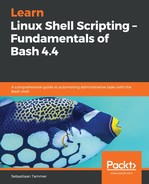- What is scheduling?
Scheduling allows us to define when and how a script should run, without the need for the user to be interactive at that time. - What do we mean with ad-hoc scheduling?
Ad-hoc scheduling, which we normally do with at on Linux, is scheduling that is not periodically repeated, but often a one-time job at a fixed time. - Where does the output of commands run with at normally go?
By default, at tries to use sendmail to send a local mail to the user who owns the queue/job. If sendmail is not installed, the output is gone. - How is scheduling for the cron daemon most often implemented?
As a user-bound crontab. - Which commands allows you to edit your personal crontab?
The command crontab -e. Furthermore, you can list the current crontab with crontab -l and remove the current crontab with crontab -r. - Which five fields are present in the crontab timestamp syntax?
- minute
- hour
- day-of-month
- month-of-year
- day-of-week
- Which are the three most important environment variables for the crontab?
- PATH
- SHELL
- MAILTO
- How can we inspect the output for scripts or commands we have scheduled with cron?
We can either use redirection in the crontab to write the output to a file, or we can use the Linux local mail functionality to send us the output. Most of the times, redirecting output to a log file is the way to go. - If our scheduled scripts do not have enough output for us to effectively work with log files, how should we remedy this?
Use the echo command in multiple places in your script, to signal a message to the reader that execution is doing what is expected. Example of this are: 'Step 1 completed successfully, continuing.' and 'Script execution was a success, exiting.'.
Chapter 14
..................Content has been hidden....................
You can't read the all page of ebook, please click here login for view all page.
